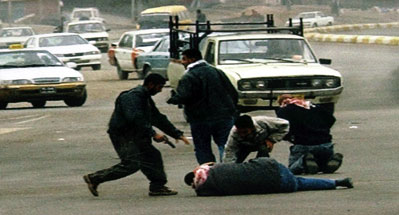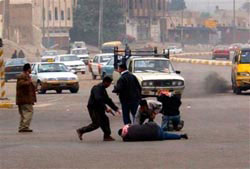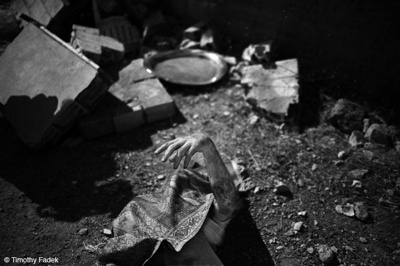Notes
Return To Haifa Street

The AP is using photographers who have relationships with the terrorists; this is for the purpose of helping to tell the terrorists’ “stories.” The photographers don’t have to swear allegiance to the terrorists–gosh, that’s reassuring–but they have “family and tribal relations” with them. And they aren’t embedded–I’m not sure I believe that–but they don’t need to be either, since the terrorists tip them off when they are about to commit an act that they want filmed.
– Michelle Malkin, April 2005 regarding AP photographers in Iraq
One day it’s AP, the next it’s Reuters. It’s not often I am the defender of the wire services, but I am when the Rathergate crowd rises up in an attempt to corner the market on the practice of photo analysis.
In light of the hysteria about widespread photo staging and doctoring from the right wing (what lgf has cleverly branded the “Fauxtography Scandal”), Eric Boehlert had a wonderfully sober piece yesterday at HuffPo casting a historical light on our authoritative friends.
The date was December ’04 and the right wing was getting steamed up about the supposedly anti-American bias among the 2005 Pulitzer Prize winners for Breaking News Photography. Of particular concern was one award winning shot depicting the execution-style murder of two Iraqi election officials on Haifa Street in Baghdad. The right had become convinced that the photographer must have been an insurgent sympathizer. How else, for example, could he have been in just the right place at the right time, and have gotten as close as he did to the actual event.
Sound familiar?
For a sample of how familiar the moral outrage and authoritativeness sounds, here’s a snippet from Powerline on December 25, 2004. (Link.) (Maybe the real tip off in suspecting this kind of “analysis,” however, is that someone apparently didn’t have anything better to do on Christmas.)
Powerlines states:
We have written a couple of times about the accusations of complicity with terrorists in Iraq…. The issue relates to the shocking photo, recently published by the AP, showing three terrorists in the act of murdering two Iraqi election workers on a street during daylight. The photographer was obviously within a few yards of the scene of the murder, which raises obvious questions, such as 1) what was the photographer doing there; did he have advance knowledge of the crime, or was he even accompanying the terrorists? and 2) why did the photographer apparently have no fear of the terrorists, or conversely, why were the terrorists evidently unconcerned about being photographed in the commission of a murder?
The photo above is the Haifa Street image exactly as featured on Michelle Malkins’ site. (The original Pulitzer shot was much bigger, and was probably the model the conservatives were working from). Just below, however, is a different version of the image. This one is featured on deadparrots.net, and (according to Parrot) was previously offered on YahooNews. (It’s likely, the pic was overly reduced. Still, the main point — irrelevant of scale — is the suddenly increase in distance between the photographer and the scene.)

How could the photographer have gotten “so close” to the actual event? In this case, it seems these visual experts had never heard of the telephoto lens.
(…If Boehlert leaves you wanting more, you can also read deadparrot.net’s analysis in which Powerline’s questions are addressed.)
(image: AP stringer, December 19, 2004. via pulitzer.org.)


Reactions
Comments Powered by Disqus